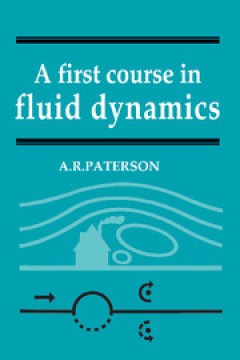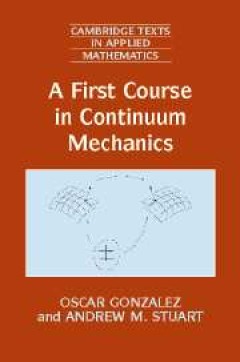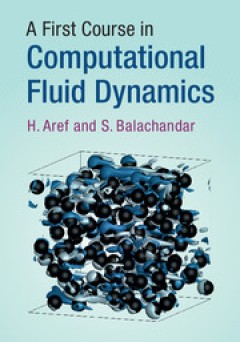Filter by

A First Course in Fluid Dynamics
How can the drag coefficient of a car be reduced? What factors govern the variation in the shape of the Earth's magnetosphere? What is the basis of weather prediction? These are examples of problems that can only be tackled with a sound knowledge of the principles and methods of fluid dynamics. This important discipline has applications which range from the study of the large-scale properties o…
- Edition
- -
- ISBN/ISSN
- 9781139171717
- Collation
- -
- Series Title
- -
- Call Number
- -

A First Course in Continuum Mechanics
A concise account of various classic theories of fluids and solids, this book is for courses in continuum mechanics for graduate students and advanced undergraduates. Thoroughly class-tested in courses at Stanford University and the University of Warwick, it is suitable for both applied mathematicians and engineers. The only prerequisites are an introductory undergraduate knowledge of basic lin…
- Edition
- -
- ISBN/ISSN
- 9780511619571
- Collation
- -
- Series Title
- Cambridge Texts in Applied Mathematics (42)
- Call Number
- -

A First Course in Computational Fluid Dynamics
Fluid mechanics is a branch of classical physics that has a rich tradition in applied mathematics and numerical methods. It is at work virtually everywhere, from nature to technology. This broad and fundamental coverage of computational fluid dynamics (CFD) begins with a presentation of basic numerical methods and flows into a rigorous introduction to the subject. A heavy emphasis is placed on …
- Edition
- -
- ISBN/ISSN
- 9781316823736
- Collation
- -
- Series Title
- -
- Call Number
- -

Fractal Flow Design: How to Design Bespoke Turbulence and Why
This book focuses on turbulent flows generated and/or influenced by multiscale/fractal structures. It consists of six chapters which demonstrate, each one in its own way, how such structures and objects can be used to design bespoke turbulence for particular applications and also how they can be used for fundamental studies of turbulent flows.
- Edition
- -
- ISBN/ISSN
- 978-3-319-33310-6
- Collation
- VII, 177 pages
- Series Title
- CISM International Centre for Mechanical Sciences
- Call Number
- -

Time-Symmetry Breaking in Turbulent Multi-Particle Dispersion
This thesis presents experimental and theoretical investigations of the connection between the time asymmetry in the short-time evolution of particle clusters and the intrinsic irreversibility of turbulent flows due to the energy cascade. The term turbulence describes a special state of a continuous medium in which many interacting degrees of freedom are excited. One of the interesting phen…
- Edition
- -
- ISBN/ISSN
- 978-3-319-19192-8
- Collation
- -
- Series Title
- -
- Call Number
- -

Thermomechanics of Composite Structures under High Temperatures
This pioneering book presents new models for the thermomechanical behavior of composite materials and structures taking into account internal physico-chemical transformations such as thermodecomposition, sublimation and melting at high temperatures (up to 3000 K). It is of great importance for the design of new thermostable materials and for the investigation of reliability and fire safety of c…
- Edition
- -
- ISBN/ISSN
- 978-94-017-7494-9
- Collation
- -
- Series Title
- -
- Call Number
- -

Thermodynamics In Nuclear Power Plant Systems
This book covers the fundamentals of thermodynamics required to understand electrical power generation systems, honing in on the application of these principles to nuclear reactor power systems. It includes all the necessary information regarding the fundamental laws to gain a complete understanding and apply them specifically to the challenges of operating nuclear plants. Beginning with defin…
- Edition
- -
- ISBN/ISSN
- 978-3-319-13419-2
- Collation
- -
- Series Title
- -
- Call Number
- -

Thermal-Hydraulic Analysis of Nuclear Reactors
This text covers the fundamentals of thermodynamics required to understand electrical power generation systems and the application of these principles to nuclear reactor power plant systems. It is not a traditional general thermodynamics text, per se, but a practical thermodynamics volume intended to explain the fundamentals and apply them to the challenges facing actual nuclear power plants sy…
- Edition
- -
- ISBN/ISSN
- 978-3-319-17434-1
- Collation
- -
- Series Title
- -
- Call Number
- -

Thermal Transport in Oblique Finned Micro/Minichannel
The main aim of this book is to introduce and give an overview of a novel, easy, and highly effective heat transfer augmentation technique for single-phase micro/minichannel heat sink. The specific objectives of the volume are to: Introduce a novel planar oblique fin microchannel and cylindrical oblique fin minichannel heat sink design using passive heat transfer enhancement techniques Investi…
- Edition
- -
- ISBN/ISSN
- 978-3-319-09647-6
- Collation
- -
- Series Title
- -
- Call Number
- -
Thermal Sensors Principles and Applications for Semiconductor Industries
This book is a comprehensive guide to both the fundamentals of thermal sensors and their advanced functions. Key topics include sensor materials, CMOS-compatible sensors, measurement capabilities, thermal management and manufacturing processes. The introductory chapter covers the basic principles of thermal sensors from the essentials of heat transfer to smart wireless sensors. Later chapters i…
- Edition
- -
- ISBN/ISSN
- 978-1-4939-2581-0
- Collation
- -
- Series Title
- -
- Call Number
- -
 Computer Science, Information & General Works
Computer Science, Information & General Works  Philosophy & Psychology
Philosophy & Psychology  Religion
Religion  Social Sciences
Social Sciences  Language
Language  Pure Science
Pure Science  Applied Sciences
Applied Sciences  Art & Recreation
Art & Recreation  Literature
Literature  History & Geography
History & Geography